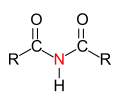Primary (chemistry)
The adjective primary (from Latin primarius ) means "first" or "first" and is also used in chemistry as a word-forming element, e.g. B. in primary product and primary reaction .
Organic chemistry
|
Central atoms marked in red in various groups of substances . Comparison of primary with secondary , tertiary and quaternary central atoms. |
||||
| primary | secondary | tertiary | quaternary | |
|
Carbon atom of an organic compound |

|

|

|

|
| alcohol |

|

|

|
does not exist |
| Amine |

|

|

|
 (see QAV ) |
| Carboxamide |

|

|

|
does not exist |
| Phosphine |

|

|

|
 (see QPV ) |
In organic chemistry , the word "primary" is a term for the degree of substitution of one of several hydrogen atoms bound to a central atom ( carbon , nitrogen , phosphorus ) by an organic radical (organyl radical, such as alkyl radical, alkenyl radical, aryl - Radical, alkylaryl radical etc.), e.g. For example, primary alcohols contain a primary carbon atom (central atom = carbon), primary amines a primary nitrogen atom (central atom = nitrogen), and primary phosphines contain a primary phosphorus atom (central atom = phosphorus).
Examples of primary central atoms
- a carbon atom in an alkane or an alcohol which has two or three hydrogen atoms in addition to a substituent , or
- a nitrogen atom in an amine attached to a carbon atom.
With all primary compounds, this means that there is almost no steric hindrance of the functional group and that typical reactions proceed easily.
Examples of such compounds are primary alcohols and primary amines. Typical examples of primary carbon atoms are the terminal carbon atom (s) in ethane or in chloromethane .
Inorganic chemistry
In inorganic chemistry a term for salts that are formed by neutralizing a hydroxyl group of a polybasic acid, e.g. B. Calcium dihydrogen phosphate, Ca (H 2 PO 4 ) 2 .
See also
Individual evidence
- ↑ According to the IUPAC nomenclature, secondary or tertiary amides are substituted with two or three acyl groups on the nitrogen. However, since primary amides with one acyl group and two hydrocarbon substituents on the nitrogen are called "tertiary amides" in common usage, classification into primary, secondary and tertiary amides is not recommended. Entry to amides. In: Römpp Online . Georg Thieme Verlag, accessed on May 15, 2019.
- ↑ Otto-Albrecht Neumüller (Ed.): Römpps Chemie-Lexikon. Volume 6: T-Z. 8th revised and expanded edition. Franckh'sche Verlagshandlung, Stuttgart 1988, ISBN 3-440-04516-1 , p. 4170.
- ^ Brockhaus ABC Chemie , VEB FA Brockhaus Verlag Leipzig 1965, p. 1134.